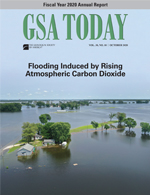Abstract View
Volume 30 Issue 10
(October 2020)
GSA Today
Article, pp. 4-10 | Full
Text |
PDF
Flooding Induced by Rising Atmospheric Carbon Dioxide
Gregory J. Retallack*
Dept. of Earth Sciences, University of Oregon, Eugene, Oregon 97403-1272, USA
Giselle D. Conde
Dept. of Earth Sciences, University of Oregon, Eugene, Oregon 97403-1272, USA
Abstract
A direct consequence of rising CO2 is increasingly devastating flooding, because
deciduous plants deploy fewer stomates each year as the atmospheric CO2 supplies more
carbon for photosynthesis. When plants transpire less, more water runs off in streams and
floods. Here we quantify this effect with high-resolution observations of changing density and
size of stomates of a mesic tree, Ginkgo, since 1754. The observed decline in maximum
potential transpiration corresponds with rising water levels in the Mississippi River and
represents a potential transpiration decline from 1829 to 2015 of 18 mL
s-1m-2: a reduction of 29%. Rising atmospheric CO2 and
declining transpiration promote flooding, which handicaps lowland cultivation and renders
irrelevant insurance and zoning concepts such as the 100-year flood.
* gregr@uoregon.edu
Manuscript received 8 Nov. 2019. Revised manuscript received 15 Apr. 2020.
Manuscript accepted 20 July 2020. Posted 13 August 2020.
© The Geological Society of America, 2020. CC-BY-NC.
https://doi.org/10.1130/GSATG427A.1
Cover Image

Search Google Scholar for
Search GSA Today
